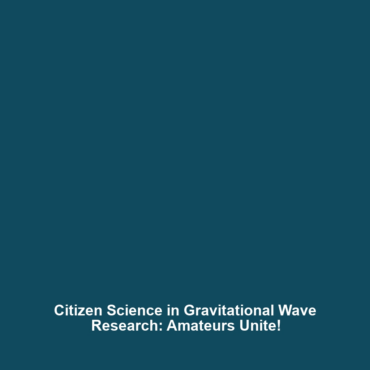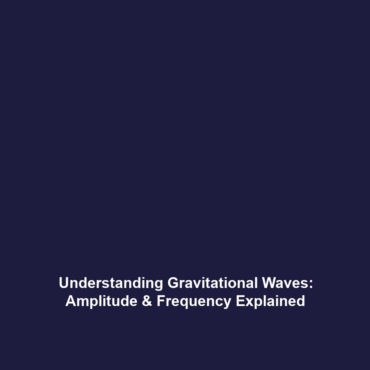Citizen Science in Gravitational Wave Research: How Amateurs Can Contribute
Introduction
Citizen Science has emerged as an essential movement in advancing the field of Gravitational Wave research, allowing amateur scientists to contribute significantly to this cutting-edge area of astrophysics. As Gravitational Waves become increasingly important for understanding the universe’s secrets, the role of citizen scientists grows vital. By harnessing the collective power of the public, researchers can enhance data analysis, engage in observation protocols, and democratize space science. This article explores how citizen contributions are reshaping our understanding of Gravitational Waves.
Key Concepts
Understanding Gravitational Waves
Gravitational Waves are ripples in spacetime produced by some of the universe’s most violent and energetic processes, such as merging black holes or neutron stars. Their detection requires sophisticated technology like the Laser Interferometer Gravitational-Wave Observatory (LIGO).
The Role of Citizen Scientists
Citizen scientists participate in research projects that analyze Gravitational Wave data, identify signals, and strive for innovative methods of detection. This collaborative approach enhances the scientific community’s capacity while encouraging public interest in astrophysics.
Applications and Real-World Uses
Citizen science initiatives have led to several practical applications within Gravitational Wave research:
- Data Analysis: Amateur scientists assist in processing vast amounts of data generated by LIGO and other observatories, helping to identify potential Gravitational Wave events.
- Public Engagement: Programs like LIGO’s Gravitational Waves Discovery attract volunteers from all walks of life, making significant contributions toward understanding cosmic events.
- Educational Impact: Schools and universities incorporate citizen science projects into their curriculums, educating the next generation on cutting-edge research.
Current Challenges
Despite the advantages of Citizen Science in Gravitational Wave research, several challenges remain:
- Data Quality: Ensuring that volunteer-generated data meets professional standards can be difficult.
- Training Requirements: The complexity of the data requires significant training for citizen scientists to be effective contributors.
- Collaboration Issues: Coordinating between professional scientists and volunteers poses challenges in communication and project management.
Future Research and Innovations
As technology evolves, the potential for Citizen Science in Gravitational Wave research expands significantly. Upcoming innovations include:
- Advanced Data Processing Tools: Machine learning algorithms are being developed to assist citizen scientists in identifying Gravitational Wave patterns.
- New Observation Techniques: Future research may unveil new ways of detecting Gravitational Waves, enhancing amateur participation.
- Global Collaborative Platforms: Initiatives to connect citizen scientists worldwide will promote greater exchange of knowledge and data.
Conclusion
In conclusion, Citizen Science is transforming Gravitational Wave research by allowing amateurs to make meaningful contributions in data analysis, public engagement, and educational outreach. The benefits of involving the public in scientific discovery are extensive, opening new avenues for exploration and fostering a greater understanding of the universe. To stay updated on advancements in this field, consider navigating to other related pages like Gravitational Wave Discoveries and Citizen Science in Astronomy.



